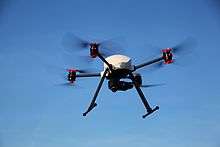PX4 autopilot
PX4 autopilot is an open-source autopilot system oriented toward inexpensive autonomous aircraft.[1] Low cost and availability enable hobbyist use in small remotely piloted aircraft. The project started in 2009[2] and is being further developed and used at Computer Vision and Geometry Lab of ETH Zurich (Swiss Federal Institute of Technology) and supported by the Autonomous Systems Lab and the Automatic Control Laboratory. Several vendors are currently producing PX4 autopilots and accessories.[3]

Overview
An autopilot allows a remotely piloted aircraft to be flown out of sight. All hardware and software is open-source and freely available to anyone under a BSD license. Free software autopilots provide more flexible hardware and software. Users can modify the autopilot based on their own special requirements.
Processor
- STM32F427 with 168 MHz ARM Cortex-M4F core[4]
- 256 KB RAM
- 2 MB Flash
- 32 bit STM32F103 fail-safe co-processor
Sensors[5]
- MPU6000 as main accel and gyro
- ST Micro 16-bit gyroscope
- ST Micro 14-bit accelerometer/magnetometer
- MEAS barometer
Software
The open-source software suite contains everything to let airborne system fly including
- QGroundControl[6] and MAVLink Micro Air Vehicle Communication Protocol[7]
- 2D/3D aerial maps (with Google Earth support)
- Drag-and-drop waypoints
See also
Other open-source robotics projects similar to PX4 include: